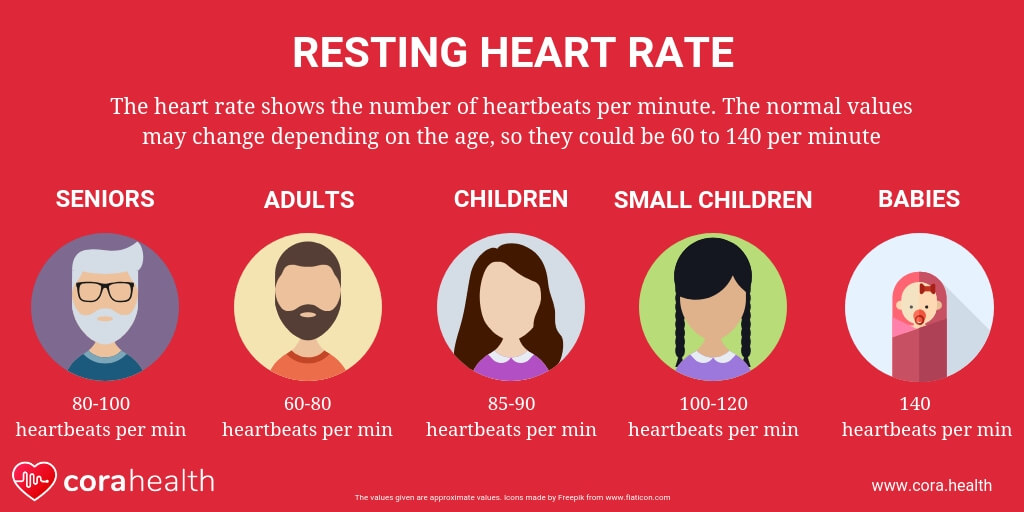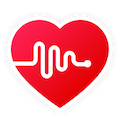Resting Heart Rate
The heart rate, also known as pulse, shows the number of heart beats per minute. The resting heart rate refers to the heart rate that is measured when you are relaxed and at rest.
The normal resting heart rate is dependent on several factors. Age, medications and conditions can have an impact on the normal pulse.
Contents:
Resting Heart Rate Chart (NHS)
The NHS defines a resting heart rate between 60 and 100 beats per minute as normal. If your resting pulse is below 40 or above 120, the NHS advises a visit to a general practitioner.
| Low resting heart rate | Normal resting heart rate | High resting heart rate | |
|---|---|---|---|
| Beats per minute | < 40 | 60-100 | > 120 |
Average resting heart rate by age

A factor that has significant influence on the normal resting heart is age. There is no normal heart rate range as with blood pressure ranges. Generally speaking, seniors and children have a higher resting heart rate than adults. The following table exhibits the average resting heart rate by age.
| Age | Heartbeats per minute |
|---|---|
| Seniors | 80 – 100 |
| Adults | 60 – 80 |
| 14 Years | 85 |
| 10 Years | 90 |
| 4 Years | 100 |
| 2 Years | 120 |
| 0 Years | 140 |
The average resting heart rate in teenagers, adults and seniors is usually between 60 and 100 beats per minute. For infants, however, 140 beats per minute are considered normal. Toddlers usually have heart rates between 100 and 120 beats per minute. This elevated resting heart rate decreases with the age of the child.
Harvard Medical School recommends to eat healthy and exercise regularly in order to lower your resting heart rate.
How to read your heart rate
The resting heart is an important way to determine the health of the cardiovascular system. Since there are many factors that can influence the pulse values, such as nervosity or exercise, it is necessary to always measure the heart rate at rest to achieve a meaningful result.
You can read your heart rate without any appliances by placing the tip of your index, middle or ring finger on the inside of your wrist or on your carotid artery. Look at the clock and count how many times the heart beats every minute. 80 beats per minute means a resting heart rate of 80.
You can also easily measure your heart rate with a blood pressure monitor. Find out which blood pressure monitors are the best ones!
Alternatively, you can read your heart rate with special devices or heart rate monitors. In order to observe the resting heart rate and to be able to detect changes, a heart rate journal can be kept. A pulse diary is similar to a blood pressure diary. You measure your heart rate at regular intervals and record the values. This can easily be done in the free app Cora Health.
What influences the heart rate?
The heart rate is influenced by several factors:
- Gender
Gender can play a role on your normal pulse rates. Oftentimes, the average resting heart rate in women is slightly higher than in men. - Age
The pulse is very much dependent on the age of a person. While unborn babies have a resting heart rate of 160 to 180, normal adult heart rate is between 60 and 100 beats per minute. - Fitness
A low resting heart rate can be a sign of physical fitness. As a result, many athletes have lower resting pulse rates between 40 and 60 beats per minute. - Medication drugs
Medication drugs can accelerate or decelerate the heart rate rate. For instance, if you take beta-blockers against hypertension, you will often experience a lower average resting heart rate. - Illness
Disease also plays a role when it comes to your resting pulse. Infections lead in most cases to slightly elevated pulse rates. - Emotions
Emotions such as stress, but als joy can make an impact on your heart rate. These extraordinary feelings often cause your pulse to temporarily rise. - Lifestyle
The consumption of stimulants such as nicotine or alcohol but also overweight can result in an increased heart rate.
What the resting pulse tells about your health
Your resting pulse can provide useful information about your health. Most of the times, a low resting heart rate (e.g. around 60 beats per seconds or even lower) can be an indicator of cardiovascular fitness, whereas a high resting heart rate can be adverse sign.
Beyond that, doctors may use information about your pulse for diagnostics. As mentioned above, an elevated heart rate can be a sign of an illness. Furthermore, it is used to determine how well the vessels are filled with blood.
As the heart rate indicates the speed and rhythm of the heartbeat, your doctor can also tell if your heart is beating smoothly or if you have a heart rhythm disorder, such as atrial fibrillation.
More information on cardiovascular health
